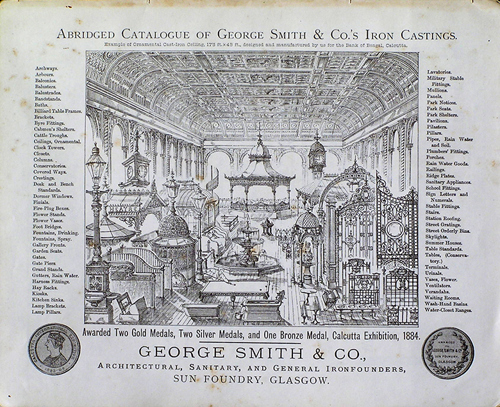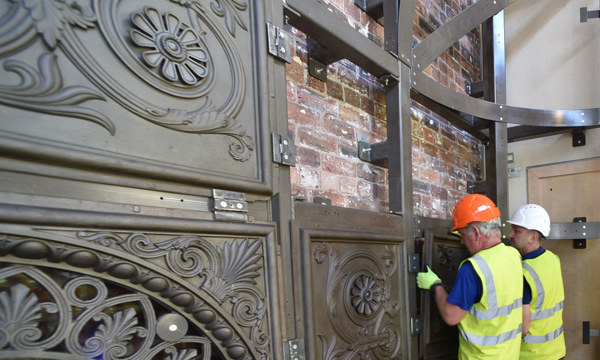A section of an important and highly decorative cast iron ceiling, made when Scotland was home to the world’s leading architectural iron founders, is to be officially unveiled at The Engine Shed on Friday 28 September.
The ceiling, which originally comprised of 66 individual cast iron panels, measured 17 feet by 17 feet when assembled and weighed in at around two tonnes, was donated by Mr John Hogg of Morayshire. It was allocated to Historic Environment Scotland (HES) in 2016 through the Cultural Gifts Scheme – an initiative that allows significant works of art and heritage objects to be donated and held for allocation for the benefit of the public. A section of 36 panels of the original ceiling will be on display at The Engine Shed.

Dating back to the late 1800s, the cast iron ceiling is from the showroom of the Glasgow-based Sun Foundry of George Smith & Co. one of the four key architectural founders of the period. A former employee of the famous Saracen Foundry, Smith established Sun Foundry in 1857. Examples of their work stretched throughout the British Empire, whilst examples closer to home include the clock tower at Bridgeton Cross, Glasgow and the Grand Fountain in Paisley, which was recently restored.
After the firm ceased operations in 1889, the ceiling remained in place at the foundry’s former building on Glasgow’s Kennedy Street, occupied by the firm of Fyfe and McGrouther, until it was refurbished in 1990. After refurbishment the ceiling ended up in the far north of Scotland where Mr Hogg recognised its significance and was able to rescue it.
The design of the showroom ceiling is the same pattern as one commissioned for the Bengal Bank in India. The 175 feet by 45 feet iron ceiling for the building’s Banking Hall was cast and produced by the Sun Foundry in 1879. The bank building was demolished in the 1980s. It appears that a second ceiling was made from the original wooden patterns to be showcased in the firm’s Glasgow showroom.
Dr David Mitchell, Director of Conservation at HES, said:
“We are delighted that The Engine Shed is able to help preserve such an important part of Scotland’s architectural and engineering heritage and I hope people come and see it on display and learn more at our Heavy Metal Weekend this Saturday.”
“This ceiling is a significant example of Scottish ironwork that showcases the quality and importance of both the material and the scale of this industry in Scotland.”
“We’re grateful to Mr Hogg for his foresight and detective skills in realising the importance of this piece. George Smith was an innovator and built his firm from very humble beginnings – I am sure he would be delighted at the esteem in which his work is now being held.”
Mr John Hogg, added:
“Created in celebration of the prestigious Bank of Bengal's 1879 Calcutta contract, today this is a most fitting 21st Century celebration of Scotland's great iron founding names and, in particular, of Glasgow's Sun Foundry design, pattern making, and moulding skills.”
“Not only is Historic Environment Scotland's custody and impressive display here at the Engine Shed a triumph of conservation. It is a triumph for all those from the demolition contractor whose foresight saved every one of its sixty six castings from the scrap metal skip, to the providers of invaluable history and context at Glasgow's Mitchell Library and at the British Library in London, and to all those professionals who enabled the securing of its exhibition to such a wide audience.”
The ceiling is being unveiled as part of Heavy Metal weekend, which is being held at The Engine Shed on Friday 28 and Saturday 29 September. There will be demonstrations of blacksmithing, casting and other have-a-go metalcrafts. Try your hand at some of our activities and create your own masterpiece to take home.
Find out more about exhibitions and events at The Engine Shed.
Notes for editors:
About the Engine Shed
About Historic Environment Scotland (HES)
- We are the lead public body charged with caring for, protecting and promoting the historic environment. We will lead on delivering Scotland’s first strategy for the historic environment, Our Place in Time.
- Historic Scotland is a sub brand of HES.
- View our press pack and keep up to date by registering for media release email alerts. If you wish to unsubscribe, please contact us.
Year of Young People 2018
The Year of Young People (YoYP 2018) will inspire Scotland through its young people aged 8 to 26, celebrating their achievements, valuing their contributions to communities and creating new opportunities for them to shine locally, nationally and globally. Over 200 young people throughout Scotland will become #YOYP2018 Ambassadors, ensuring their communities know about local opportunities to celebrate young people.
Follow Historic Environment Scotland
Twitter: @HESEngineShed
Facebook: @HESEngineShed
Instagram: @HistEnvScot
Historic Environment Scotland Media Office
Direct line: 0131 668 8714
Email: communications@hes.scot


